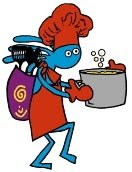A mere 83 hours after leaving New York City, the Transcontinental Express train arrives in San Francisco.
That
any human being could travel across the entire nation in less than four
days was inconceivable to previous generations of Americans. During
the early 19th century, when Thomas Jefferson
first dreamed of an American nation stretching from "sea to shining
sea," it took the president 10 days to travel the 225 miles from Monticello to Philadelphia via carriage. Even with frequent changing of horses, the 100-mile journey from New York
to Philadelphia demanded two days hard travel in a light stagecoach.
At such speeds, the coasts of the continent-wide American nation were
months apart. How could such a vast country ever hope to remain united?
As
early as 1802, Jefferson had some glimmer of an answer. "The
introduction of so powerful an agent as steam," he predicted, "[to a
carriage on wheels] will make a great change in the situation of man."
Though Jefferson never saw a train in his lifetime, he had glimpsed the
future with the idea. Within half a century, America would have more
railroads than any other nation in the world. By 1869, the first
transcontinental line linking the coasts was completed. Suddenly, a
journey that had previously taken months using horses could be made in
less than a week.
Five days after the transcontinental railroad
was completed, daily passenger service over the rails began. The speed
and comfort offered by rail travel was so astonishing that many
Americans could scarcely believe it, and popular magazines wrote glowing
accounts of the amazing journey. For the wealthy, a trip on the
transcontinental railroad was a luxurious experience. First-class
passengers rode in beautifully appointed cars with plush velvet seats
that converted into snug sleeping berths. The finer amenities included
steam heat, fresh linen daily, and gracious porters who catered to their
every whim. For an extra $4 a day, the wealthy traveler could opt to
take the weekly Pacific Hotel Express, which offered first-class dining
on board. As one happy passenger wrote, "The rarest and richest of all
my journeying through life is this three-thousand miles by rail."
The
trip was a good deal less speedy and comfortable for passengers
unwilling or unable to pay the premium fares. Whereas most of the
first-class passengers traveled the transcontinental line for business
or pleasure, the third-class occupants were often emigrants hoping to
make a new start in the West. A third-class ticket could be purchased
for only $40--less than half the price of the first-class fare. At this
low rate, the traveler received no luxuries. Their cars, fitted with
rows of narrow wooden benches, were congested, noisy, and uncomfortable.
The railroad often attached the coach cars to freight cars that were
constantly shunted aside to make way for the express trains.
Consequently, the third-class traveler's journey west might take 10 or
more days. Even under these trying conditions, few travelers
complained. Even 10 days spent sitting on a hard bench seat was
preferable to six months walking alongside a Conestoga wagon on the Oregon Trail.
Railroad promotions, however, naturally focused on the speedy express trains.
The arrival of the Transcontinental Express train in San Francisco on
this day in 1876 was widely celebrated in the newspapers and magazines
of the day. With this new express service, a businessman could leave
New York City on Monday morning, spend 83 hours in relaxing comfort, and
arrive refreshed and ready for work in San Francisco by Thursday
evening. The powerful agent of steam had effectively shrunk a vast
nation to a manageable size.(Source: The History Channel , Retrieved May 6, 2012)
Foods fit for Traveling: Both recipes selected this month and shown below are foods-fit-for-traveling in the old west.
OVEN-DRIED BEEF JERKY
The recipe is from "Cowboy Cook Book"; permission to print granted by Golden West Publishers in Phoenix, AZ. Cowboys often carried a supply of jerky to eat during the long nights of cattle tending. - 2 - 2½ lbs. boneless BEEF MARINADE
- 1 cup WATER
- 2 Tbsp. LIQUID SMOKE
- ¼ tsp. SALT
- ¼ tsp. BLACK PEPPER
- 1 tsp. GARLIC SALT
- 1 tsp. LEMON PEPPER
Trim fat from meat and cut into strips that are 6 inches long and ⅛-inch thick. Place strips in a glass casserole dish. In a bowl, combine marinade ingredients and stir well. Pour over beef. Cover and marinate overnight in refrigerator, stirring occasionally. Drain and dry meat thoroughly. Cover bottom rack of oven with aluminum foil . Arrange strips of meat close together on oven rack; do not overlap. Bake at 150°-175° for 10-12 hours. Beef is done when pieces feel dry, not crisp. Store in airtight containers.
Hard Tack
Biscuits
These biscuits, made without
baking powder or baking soda, became as hard as rocks. The cowboys softened
them in coffee, stew or just plain water to make them edible.
|
HARDTACK
The recipe below is from "Arizona Territory Cook Book"; permission to print granted by Golden West Publishers in Phoenix, AZ.- 4 cups FLOUR
- 4 tsp.SALT
- WATER
Mix flour and salt together. Add just enough water to make a heavy dough that will not stick to the hands. Roll the dough until it is ½ inch thick. Cut into pieces about 3 inches square and then punch 16 holes in each piece with a nail. Turn pieces over and punch through again. Bake on ungreased light metal sheet in oven about 375 degrees for half an hour. Tack should be light brown on both sides.
Hardtack is broken fairly easily when fresh, but as it dries out it gets hard as fired brick.
